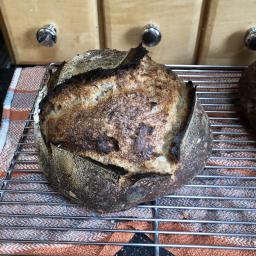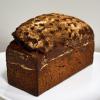Hi All,
I seem to be baking a lot these days... It's still hot though here in NYC so things are rising fast around here... Last night I was reading Local Breads by Dan Leader, page 105 which talks about the Poilane bakery loading their breads into the oven every 2 hours... I wanted to see how quickly I could make a pain au levain, assuming the levain was ripe and ready... Also, a have recently converted my storage sourdough starter from liquid to very stiff (50% hydration). Here's what happened:
Stiff Levain Recipe:
400g Stone Ground White Whole Wheat Flour (King Arthur)
200g Water
80g Stiff Sourdough Starter (50% hydration)
680g Total Stiff Levain
Final Dough Recipe:
1374g AP (King Arthur)
926g Water
32g Kosher Salt
680g Stiff White Whole Wheat Levain (approx 50% hydration)
3012g Total Dough Yield
Method of Madness:
9/6/10
5:30pm - Mix stiff levain, knead into ball, cover and let rest.
5:45pm - Knead stiff a few times until smooth, lightly coat with extra virgin olive oil, place in covered plastic tub, refrigerate at 40F 23-36 hrs. If you are going to make the dough within 12-16 hours, and it's not too hot, then you can probably leave it out on the kitchen counter...
9/7/10
6:35pm - Come home from work, get settled, take stiff levain out of fridge, measure out all ingredients using a digital scale.
6:55pm - In a large mixing bowl, pour in exact amount of water, then cut up the stiff levain into small golf ball sized pieces and place it into the bowl in the water. Then add all the flour on top, then the salt. Start mixing with a large rubber spatula until a shaggy dough forms. Then using wet hands, squish the dough until the levain is well combined, knead for about 10 minutes. Do all kneading in the bowl without adding any extra flour. If your hands get sticky, use a plastic scraper to scrape the dough off your hands, then dip your hands in water and continue kneading.
7:10pm to 7:30pm - cover and let rest for 20 minutes.
7:30pm - Turn dough in bowl, and knead for about 15-20 seconds, cover and let rest.
8:00pm - Turn dough in bowl, and knead for about 15-20 seconds, cover and let rest.
8:30pm - Turn dough, cover and let rest.
9:00pm to 9:10pm - Divide dough into 4 pieces, preshape into boules, place them seam side down on a proofing board with no extra flour. Cover and let rest for 20 minutes.
9:30pm - Final shape into batards, place them seam side up in a very lighty floured couche, cover with tea towels and plastic bag, proof for approx 1 hr and 30 minutes.
10:20pm - Place 2 baking stones in oven on 2 different levels along with steam pan, preheat to 550F with convection.
11:10pm - Turn off convection. Turn out loaves onto peel/flipping board, slash as desired, place into oven directly on stone. When all the loaves are in, place 1 1/2 cups water into steam pan, close door, turn oven down to 450F, bake for 45 minutes rotating batards halfway through the bake between stones. After 45 minutes, check weight and internal temp. They should be about 15% lighter than their pre-baked weight, and the internal temp should be between 205F to 210F. I prefer 210F. Turn oven off, and place batards back into oven for 5 minutes. After this, let batards cool completely before cutting...
12:00am - Done... Time for sleep... Pics up tomorrow sometime...
8:50am - Upload pics...


Tim












 The beautiful leaf shape was shortly admired and much more rapidly dismantled by my fellow pub mates! I've tried these with a variety of additions - roasted garlic, sun-dried tomatoes, and traditional anchovies. In any incarnation, I find them quickly devoured. And let's face it, they are a 'fun' bread because of their distinctive shape.
The beautiful leaf shape was shortly admired and much more rapidly dismantled by my fellow pub mates! I've tried these with a variety of additions - roasted garlic, sun-dried tomatoes, and traditional anchovies. In any incarnation, I find them quickly devoured. And let's face it, they are a 'fun' bread because of their distinctive shape.



